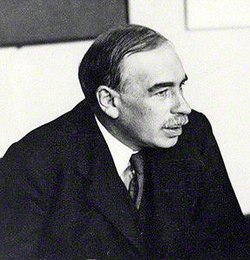
Back الثورة الكينزية Arabic Kejnsisma revolucio Esperanto Revolución keynesiana Spanish Révolution keynésienne French Revolusi Keynesian ID 케인스 혁명 Korean Keynesçilik Turkish

| Part of a series on |
| Economics |
|---|
The Keynesian Revolution was a fundamental reworking of economic theory concerning the factors determining employment levels in the overall economy. The revolution was set against the then orthodox economic framework, namely neoclassical economics.
The early stage of the Keynesian Revolution took place in the years following the publication of John Maynard Keynes' General Theory in 1936. It saw the neoclassical understanding of employment replaced with Keynes' view that demand, and not supply, is the driving factor determining levels of employment. This provided Keynes and his supporters with a theoretical basis to argue that governments should intervene to alleviate severe unemployment. With Keynes unable to take much part in theoretical debate after 1937, a process swiftly got underway to reconcile his work with the old system to form neo-Keynesian economics, a mixture of neoclassical economics and Keynesian economics. The process of mixing these schools is referred to as the neoclassical synthesis, and Neo-Keynesian economics may be summarized as "Keynesian in macroeconomics, neoclassical in microeconomics".
© MMXXIII Rich X Search. We shall prevail. All rights reserved. Rich X Search